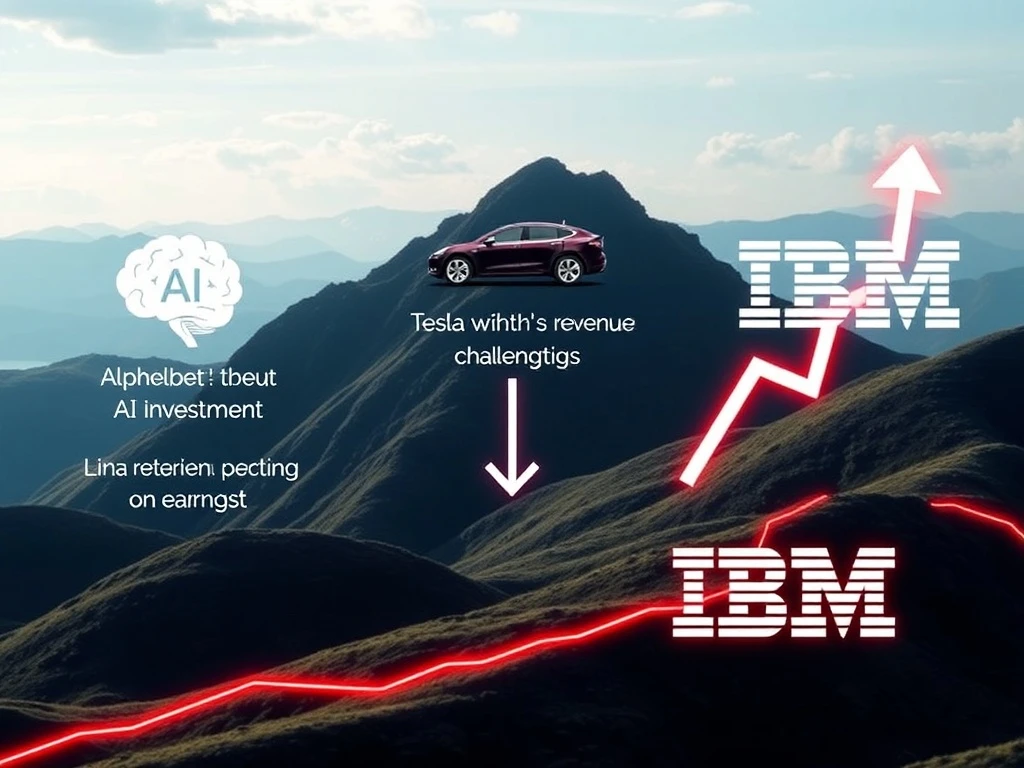Tech Earnings Unveiled: Alphabet’s Astounding AI Bet, Tesla’s Roadblocks, and IBM’s Resurgence

The U.S. tech earnings season has officially opened, delivering a fascinating mix of triumphs and tribulations from industry giants like Alphabet, Tesla, and IBM. For investors, especially those keenly observing the broader tech landscape that often influences cryptocurrency markets, these initial reports offer critical insights into growth, resilience, and strategic shifts. This opening salvo of Tech Earnings provides a crucial barometer for the sector’s health, revealing divergent paths for innovation and market adaptation.
Alphabet’s AI Investment: A Glimpse into the Future
Alphabet emerged as a standout performer in the initial wave of Tech Earnings reports. The tech behemoth not only surpassed its revenue and earnings forecasts but also significantly ramped up its commitment to artificial intelligence. This aggressive push into AI signals a clear strategic direction for the company, aligning with the industry’s broader trend towards leveraging AI for competitive advantage.
- Revenue Beat: Alphabet’s second-quarter revenue hit $96.43 billion, comfortably exceeding the $94 billion forecast. This growth was fueled by strong performances across its core businesses.
- Massive AI Spending Increase: The company’s 2025 capital spending target saw a substantial jump from $75 billion to $85 billion. This $10 billion increase is primarily earmarked for accelerating AI development and infrastructure, showcasing immense confidence in its cloud and search services.
- Cloud and Ad Dominance: Google Cloud revenue reached $13.62 billion, outpacing estimates, while ad revenue saw a healthy 10.4% year-over-year growth to $71.34 billion. These figures underscore Alphabet’s ability to monetize its AI-driven services effectively.
This increased AI Spending by Alphabet is a strong signal to the market, indicating that the race for AI supremacy is intensifying. Competitors like Microsoft and Amazon are also scaling their investments, suggesting that AI will remain a pivotal growth driver for the foreseeable future.
Tesla Revenue: Navigating Challenges in the EV Landscape
In contrast to Alphabet’s strong showing, Tesla’s latest earnings report presented a more challenging picture, underscoring the near-term volatility within the electric vehicle (EV) market. The company fell short of analyst expectations on both revenue and earnings, raising questions about its immediate profitability and growth trajectory.
Here’s a snapshot of Tesla’s performance:
| Metric | Forecast | Actual | Variance |
|---|---|---|---|
| Adjusted EPS | $0.42 | $0.40 | -$0.02 |
| Total Revenue | $22.74 billion | $22.5 billion | -$0.24 billion |
| Automotive Revenue (YoY) | – | $16.7 billion (16% drop) | Significant Decline |
| Regulatory Credit Sales | – | $439 million (from $890 million) | Steep Drop |
The decline in Tesla Revenue was attributed to several factors, including production challenges and a strategic shift towards launching lower-cost models, with a cheaper EV planned for 2025. Furthermore, political controversies surrounding CEO Elon Musk, particularly his high-profile endorsements and policy changes at his DOGE initiative, were cited as factors that compounded consumer sentiment risks. Investors are now keenly watching for Tesla’s ability to deliver on its cost reduction goals and its plans for volume growth with more affordable models.
IBM Earnings: A Quiet Comeback in Enterprise Tech
IBM delivered a surprisingly robust performance, showcasing a strong turnaround that defied initial market skepticism. The tech veteran posted impressive growth figures, particularly in its software and hybrid cloud divisions, signaling the value of its strategic acquisitions and enterprise AI integration efforts.
- Revenue Surge: IBM’s revenue rose 8% year-over-year to $16.98 billion, surpassing the $16.59 billion forecast.
- Earnings Beat: Adjusted earnings per share reached $2.80, comfortably above the $2.64 estimate.
- Hybrid Cloud Momentum: The software division reported $7.39 billion in revenue, with hybrid cloud services growing by a significant 16%. This highlights IBM’s successful pivot towards a cloud-centric strategy.
- Stock Performance: Despite a 5% decline in after-hours trading post-earnings, IBM’s stock remained up an impressive 28% year-to-date, outperforming the S&P 500’s 8% gain.
IBM also reaffirmed its ambitious $13.5 billion free cash flow target for 2025, buoyed by strategic moves like the z17 mainframe launch and the Hakkoda acquisition. The strong IBM Earnings underscore the company’s successful execution of its long-term strategy, focusing on enterprise solutions and leveraging its extensive client base for cloud and AI adoption.
The Broader Impact of Tech Earnings: What Does It Mean for the Market?
The initial wave of Tech Earnings reports painted a picture of divergent strategies and varied market conditions. Alphabet’s aggressive pursuit of Alphabet AI and IBM’s steady growth in cloud services signal confidence in long-term innovation and enterprise solutions. Conversely, Tesla’s struggles highlight the immediate challenges and intense competition within the EV sector.
Analysts note that Alphabet’s results demonstrate its unparalleled ability to monetize AI-driven services, particularly in its dominant search and expanding cloud computing segments. For Tesla, while the company’s guidance for cost reductions and a more affordable EV model offers a potential path to volume growth, investors remain cautious about its near-term profitability and the impact of external controversies. IBM’s performance, meanwhile, serves as a testament to the effectiveness of strategic acquisitions and a focused approach to enterprise AI integration.
Market concentration risks remain elevated, with Alphabet, Tesla, and IBM collectively accounting for over 5% of the S&P 500’s weight. The opening day of the earnings season has left investors balancing optimism for AI-driven growth against caution over sector-specific challenges. With the tech-heavy index showing mixed momentum, attention now shifts to subsequent reports from other “Magnificent Seven” firms to gauge whether these initial trends will persist throughout the season.
In conclusion, these early Tech Earnings reports provide a crucial snapshot of the evolving technology landscape. While AI emerges as a clear growth engine, companies face unique challenges in their respective markets. Investors will need to carefully dissect future reports to navigate this dynamic environment and identify resilient opportunities.
Frequently Asked Questions (FAQs)
Q1: What were the key takeaways from Alphabet’s earnings report?
Alphabet exceeded revenue and earnings forecasts, driven by strong growth in core businesses. The most significant takeaway was its increased AI Spending, raising its 2025 capital spending target to $85 billion, reflecting deep confidence in AI-driven cloud and search services.
Q2: Why did Tesla’s revenue miss expectations?
Tesla’s revenue fell short due to weaker-than-expected automotive sales, a 16% year-over-year drop in automotive revenue, and a significant plummet in regulatory credit sales. Production challenges, a shift towards lower-cost models, and political controversies surrounding CEO Elon Musk were cited as contributing factors to the Tesla Revenue miss.
Q3: How did IBM’s earnings perform, and what drove its growth?
IBM reported robust IBM Earnings, with revenue rising 8% year-over-year and adjusted earnings per share surpassing estimates. Its growth was primarily driven by strong performance in its software division and a 16% growth in hybrid cloud services, highlighting the success of its strategic acquisitions and enterprise AI integration.
Q4: What is the significance of increased AI Spending by tech giants like Alphabet?
The increased AI Spending by tech giants like Alphabet signifies an intensifying race for AI supremacy and a strong belief that AI will be a primary driver of future growth. It indicates that companies are heavily investing in AI infrastructure and development to enhance existing services and create new revenue streams, particularly in cloud computing and search.
Q5: What do these initial Tech Earnings reports suggest about the broader market?
These initial Tech Earnings reports suggest a mixed but dynamic market. They highlight divergent strategies, with AI and cloud computing emerging as strong growth areas, while sectors like EVs face near-term volatility. The reports also underscore continued market concentration risks among the largest tech firms, setting the stage for the rest of the earnings season.








